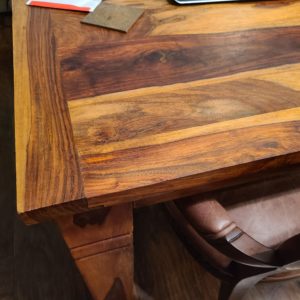I’m coming up with a game plan to finish this table. Currently I think it is completely natural, very grainy. Was imported from India.
I have plotted a small test area that have cleaned with dish detergent and sanded with 150, then 320. I was going to use Shellac with the wax removed. Any thoughts?
If all goes well I was going to do 3 or 4 thin coats. The table gets alot of use. I was thinking about a top coat. But, from what I have read rosewood is tough to seal.
Any thoughts or plans on this project would be greatly appreciated!
Jon














Replies
Shellac is a great very good choice you may want to mix your own much better than store bought stuff. cheers
Sanding 320 grit after 150 is too large a gap, follow-up 150 with 220 . Shellac is not very resistant to water and alcool, probably not the best choice for a kitchen table that will see a lot of use, go with a tough varnish, oil or water based and clean the wood with alcool or acetone moments before the first coat.
150, 220, 320. 3 coats of relaxed shellac. Top coat with water based poly to keep the color as it is, or oil based if you want a more yellow hue.
Shellac will seal the rosewood and help adhere the final finish. But shellac will get destroyed on a kitchen table pretty quick. A more durable topcoat such as the poly will adhere to the shellac and provide the protection you need.
Making sure your shellac is completely stress-free is VERY important. Music helps.
It likes it when I sing.
As stated, shellac is not a high wear area finish of choice. That siad, I use a lot of shellac for a one man shop. We see plenty of 100 year old occasional tables and other pieces with shellac finishes. These pieces were probably treated tenderly.
I would start at 200 grit unless the surface is in really bad shape and needs to be re-shaped. Even 220 grit can alter your dimensions but, a hard flat block can help you avoid rounding over edges and so forth.
A dewaxed shellac like Zinsser's Seal Coat, 2 or 3 very thin coats followed by a more resilient top coat would be my choice. As mentioned Minwax Polycrylic (I can't believe I am recommending Minwax but, this product is a winner for them) stays very clear over time (no yellowing) an oil based varnish will add some warmth.
If your table is already dark, try the Polycylic. If it is still pale after the shellac (which I doubt) use an oil based poly.
Sure most of us shy away from poly for its plasticky look but, for tables and floors it's a good choice. There are other durable finishes but, I get the impression you don't do this a lot so let's keep it simple.
P.s. I believe John meant DE-Waxed, not RE-Laxed ;-)
Yeah, and he knows I know, 'ya know?
Thanks everyone for their input. Special thanks Gee Dub. I like your plan! A question about sanding. The table is made with 7 slabs and end boards. There a hair under an 1.25 inches in thickness. The seems are all over the place. Should l try to knock all the seems down or leave as is?
Thanks again everyone, great forum!
Here's a pic
Acacia
This forum post is now archived. Commenting has been disabled